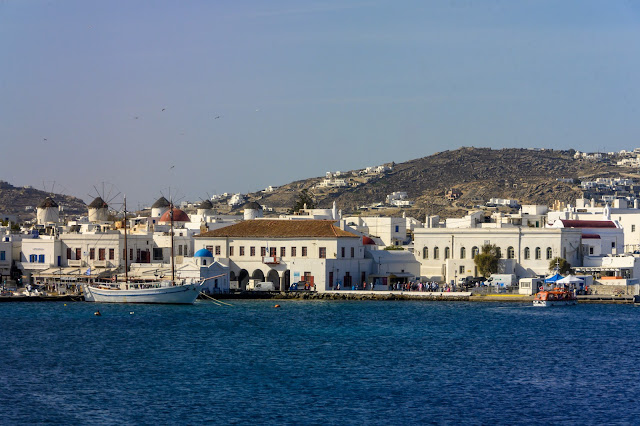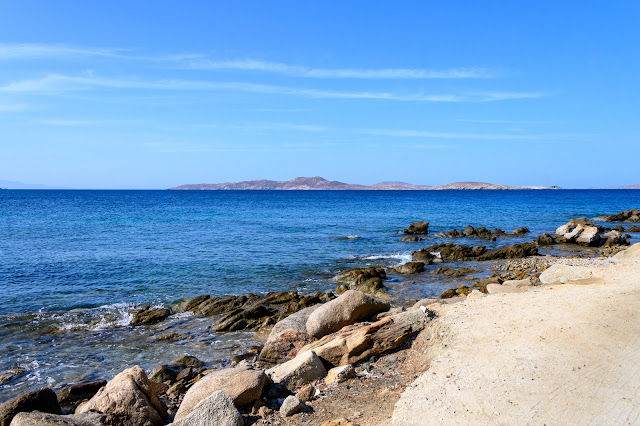"Once upon a time in an island not so far away, there was a god by the name of Apollo who ruled over light and music. As gods do, Apollo had some offspring which eventually led to the birth of Mykonos. Being a descendant of Apollo, Mykonos was destined for greatness — which he successfully fulfilled as he was the one who hosted the great battle between Zeus and the Titans!"
According to Greek mythology, Zeus annihilated the Titans and imprisoned them under the island’s terrain in a region called Choulakia. If you ever walk near that region, you’re kind of treading on the prison cells of some of the strongest beings in Greek mythology."
Mykonos is Technically a Mythological Graveyard!
Yes! as you can tell, we have arrived at the Island of Mykonos and hopefully our footsteps won't awaken the dead.
Mykonos is one of 220 large and small islands comprising the Cyclade Islands.
"The Cyclades is an island grouping in the Aegean Sea located southeast of mainland Greece. The word “Cyclades” is derived from the Greek word kyklos (κύκλος), meaning “circle”, because the islands in this cluster form a circle around the sacred island of Delos."
Mykonos or "The Island of the Winds"as it's called, due to the very strong winds that usually blow on the island, is one of the most popular islands in Greece.
"Mykonos became popular with international "jet set" tourists in the 1960s. In the 70s it was popular spot for Americans to treat as a nude beach, which Americans imagined to be a feature of those natural "far out" Greeks, and by the 2000s, Mykonos had become one of Greece's most expensive islands."
Tourism is a major industry;over half a million visitors a year, due to being known for its vibrant nightlife, gorgeous beaches, and its architectural designs.
"The totally white buildings with the colorful gardens, the stone paved paths and the light blue churches are some of the most typical characteristics of the Cycladic architecture. Most of the buildings are really simple and of minimalistic aesthetics, while they’re also built quite far from the shore and have small windows. That is part of the defense against piracy, which used to be a problem of major importance for the inhabitants of the islands, which is also why on some islands the houses and villages are built behind strong, stone walls. Most of the buildings only have one floor and their timbers never surpass the 3 meter mark, while they are built southeast. The walls have a 60-80cm width and, as mentioned before, the windows are very small with only one of them being on the north side. Traits that came to be, simply due to the fact that the people wanted to keep the temperatures in desired levels all year long, cool during the summer and warmer during winter."

"Taking a walk along the streets of Mykonos, one sees the Cycladic architecture in its full glory, and one notices that in the sea of whitewashed buildings, color pops up every now and then. Every door and window frame were painted in blue color, and once again, there is a story behind it.
Fishermen used bright blue paint on their boats, as it was the cheapest and most accessible option, and they would use the leftover blue paint for their houses as well. The blue color was very easy to make – it was a mixture of whitewash and a specific cleaning product in the form of a blue powder called “loulaki,” which every household had at the time."
"During the cholera outbreak in 1938, the government stated that it was mandatory to paint all houses in whitewash. It might sound silly that paint was used to fight a powerful disease, but the whitewash they made contained limestone, a very strong disinfectant. So, people began painting as a way to sanitize their homes and stop the pandemic from spreading.Believe it or not, painting a house in any color other than white or blue was illegal on Greek islands at one point. During the military dictatorship in Greece in 1967, the iconic color scheme was no longer optional – it was a mandatory policy.Even a new law was issued in 1974, making it official. It was a way to promote nationalism and patriotism in the country, and here is how they are related: white and blue are the colors of the Greek flag. Even after the law was changed, locals continued the tradition of the specific color palette."
"Mykonos island was once known for having hundreds of windmills that could be seen from miles away. They were used to grind grain by islanders and were a reminder of an old tradition brought by Venetians who effectively ruled the island until the 16th century.
With the arrival of the 20th century and more efficient technologies, the windmills were replaced as the most numerous structures in Mykonos.
"Now churches reign unchallenged as the most recognizable feature on this Greek island.
There are over 1200 churches today on the island, meaning that there is roughly one church for each family living in Mykonos. However, not all were built to hold services.
According to the tradition, most of them were built by families that wished to secure safe passage to the afterlife for their loved ones when they passed away. But there is also a historical element playing a major role in this religious expression."

With a little history, some mythology, and a whole lot of photographs, tis time to conclude this part of the post and move on to the next.
Next post will cover the iconic and most visited sites by tourists, including us, of the island of Mykonos.































































0 comments:
Post a Comment